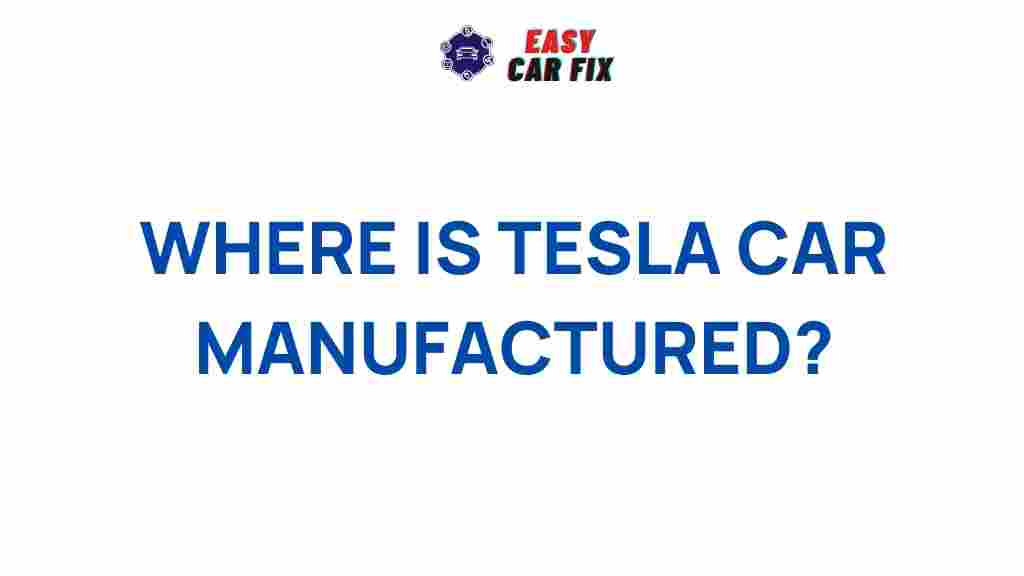Tesla: Uncovering the Intriguing Origins of Tesla’s Manufacturing
When discussing the automotive industry, few names resonate as powerfully as Tesla. This brand has redefined what it means to manufacture electric vehicles, challenging traditional production methods and supply chain logistics. In this article, we will delve into the fascinating origins of Tesla’s manufacturing processes, exploring how innovation has shaped the company’s approach to car production, assembly, and factory operations.
The Birth of Tesla
Tesla, Inc. was founded in 2003 by Martin Eberhard and Marc Tarpenning, with the goal of accelerating the world’s transition to sustainable energy. The company’s name pays tribute to Nikola Tesla, the inventor and electrical engineer whose work laid the groundwork for modern electric power systems. From its inception, Tesla aimed to challenge the conventional automotive industry by focusing on electric vehicles (EVs) that would appeal to a broad market.
Innovation at the Core
Innovation is a cornerstone of Tesla’s identity. Unlike traditional car manufacturers that heavily rely on internal combustion engines, Tesla has concentrated on developing cutting-edge battery technology and electric drivetrains. This commitment to innovation has been pivotal in shaping Tesla’s manufacturing process, leading to several key advancements:
- Battery Technology: Tesla’s Gigafactories are designed to produce lithium-ion batteries on a massive scale, significantly reducing costs and enhancing performance.
- Vertical Integration: Unlike many car manufacturers that outsource components, Tesla controls a significant portion of its supply chain, allowing for greater flexibility and quality control.
- Software Development: Tesla vehicles are equipped with advanced software that allows for over-the-air updates, ensuring that cars improve over time.
The Tesla Production Line
The production of Tesla cars involves a meticulously planned assembly line designed to optimize efficiency and minimize waste. Here’s a step-by-step breakdown of how Tesla cars are manufactured:
Step 1: Design and Engineering
Before any vehicle is produced, extensive design and engineering work is conducted. Tesla’s design team focuses on creating vehicles that are not only aesthetically pleasing but also aerodynamically efficient. This stage is crucial for ensuring that the car performs well and meets safety standards.
Step 2: Sourcing Materials
Tesla places a strong emphasis on sourcing high-quality materials. The company maintains relationships with suppliers to secure the best components for their vehicles. This includes everything from the metals used in the chassis to the components in the battery packs. The supply chain is a critical aspect of Tesla’s operations, influencing both production costs and the overall quality of the cars manufactured.
Step 3: Manufacturing Components
Once materials are sourced, Tesla manufactures key components in-house or through trusted suppliers. The company operates several Gigafactories, where large-scale battery production takes place. These facilities are designed to maximize production efficiency and minimize the carbon footprint.
Step 4: Assembly Process
The assembly of Tesla cars occurs in a streamlined process that utilizes advanced robotics alongside human labor. Key features of the assembly process include:
- Automation: Robotics play a significant role in the assembly line, performing repetitive tasks with precision and speed.
- Quality Control: Each vehicle undergoes rigorous testing to ensure it meets Tesla’s high standards before leaving the factory.
- Customization: Tesla allows customers to customize certain aspects of their vehicles, which are then integrated into the assembly line process.
Step 5: Quality Assurance
After assembly, Tesla conducts quality assurance checks to identify any potential issues. This stage is essential for ensuring that every car manufactured is reliable and safe for consumers.
Troubleshooting Common Manufacturing Challenges
Even with a well-oiled production machine, challenges can arise. Here are some common issues faced in Tesla’s manufacturing processes, along with troubleshooting tips:
- Supply Chain Disruptions: Global events can impact the availability of materials. Tesla mitigates this risk by diversifying its supplier base and maintaining strong relationships with key partners.
- Production Delays: Manufacturing delays can occur due to equipment failures or labor shortages. Tesla addresses this by investing in preventive maintenance and employee training programs.
- Quality Issues: If defects are found post-production, Tesla uses data analytics to trace the problem back to its source, allowing for rapid rectification and improvements in future production.
The Role of Gigafactories
Tesla’s Gigafactories play a crucial role in the company’s manufacturing success. These massive facilities are designed to significantly reduce the cost of battery cells and packs, which are essential for electric vehicles. Here’s how Gigafactories contribute to Tesla’s production:
- Economies of Scale: By producing batteries at a larger scale, Tesla can lower the cost per unit, making electric vehicles more affordable.
- Reducing Carbon Footprint: Gigafactories are designed with sustainability in mind, utilizing renewable energy sources to power operations.
- Localized Production: By building factories close to key markets, Tesla can reduce shipping costs and improve delivery times.
Future Innovations in Tesla Manufacturing
As Tesla continues to grow, the company is exploring new innovations that could further revolutionize the automotive manufacturing process. Some potential advancements include:
- 3D Printing: The integration of 3D printing technology could streamline the production of certain components, reducing waste and lead times.
- AI and Machine Learning: Utilizing AI for predictive maintenance and quality assurance can enhance production efficiency and reduce downtime.
- Advanced Robotics: Continued investment in robotics will likely increase precision and reduce the labor costs associated with assembly.
Conclusion
The origins of Tesla’s manufacturing are rooted in a commitment to innovation, sustainability, and quality. By embracing advanced technologies and maintaining a strong focus on supply chain management, Tesla has set itself apart in the automotive industry. The company’s unique approach to car production and assembly has not only transformed its own operations but has also influenced the broader market, pushing traditional manufacturers to reconsider their practices.
As Tesla continues to evolve, its manufacturing processes will likely adapt to meet the challenges of the future. The intriguing origins of Tesla’s manufacturing journey serve as a testament to the power of innovation in reshaping industries and paving the way for a sustainable future.
This article is in the category Reviews and created by EasyCarFix Team
